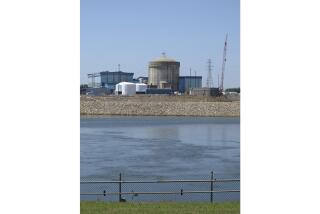North Carolina regulators order Duke Energy to contain 2nd leak
DURHAM, N.C. -- State regulators in North Carolina have ordered Duke Energy to contain a newly discovered leak of coal ash from a second storm-water pipe at a storage basin on the Dan River, where an earlier ruptured pipe released a massive coal ash spill on Feb. 2.
The action came as the U.S. Fish and Wildlife Service reported finding up to 70 miles of the river bottom coated with coal ash 5 feet thick in some places.
The state Department of Environment and Natural Resources, under fire from environmental groups who have accused the agency of trying to protect Duke, said Tuesday that it had discovered elevated levels of arsenic from the second pipe. The agency described it as âan unauthorized discharge.â
An agency spokesman, Jamie Kritzer, said regulators did not know how long coal ash has been seeping from the second pipe -- or how much ash may have been released into a river already contaminated by the previous spill. Duke says 30,000 to 39,000 tons of coal ash and 27 million gallons of contaminated coal ash water were dumped into the river Feb. 2.
The second pipe is a 36-inch diameter, 1,000-foot-long reinforced concrete structure beneath the same 27-acre coal ash basin where a 48-inch pipe ruptured on Feb. 2. The agency ordered Duke to plug the leak; it took the utility a week before it announced it had stopped the initial spill.
âGiven what weâve seen, weâre concerned that this second stormwater pipe on site may also be leaking water contaminated with coal ash pollutants into the Dan River,â Tom Reeder, director of the N.C. Division of Water Resources, said in a statement late Tuesday. âAs such, we are ordering Duke Energy to eliminate this unauthorized discharge immediately.â
The U.S. Fish and Wildlife Service said Tuesday that it had found up to 5 feet of ash coating the river bottom in a âcoal ash barââ 75 feet long and 15 feet wide near the Feb. 2 spill site. In other parts of the river bottom within two miles of the spill site, the agency found up to 5 inches of coal ash.
Farther downstream, between one-eighth to one-half inch of coal ash was found near South Boston, Va., 70 miles from the spill site.
Tom MacKenzie, a spokesman for the federal agency, said in an interview that the coal ash deposits are ârather significantâ and âfairly pervasiveâ in the river. The agency said turbidity, a measure of how clear or cloudy the water is, exceeded state water quality standards.
More tests will be required to determine any harm to fish, mussels and wildlife, Tom Augspurger, a contaminant specialist for Fish and Wildlife, said in a statement.
Also Tuesday, the state environmental agency released the latest results of tests on water samples showing levels of the heavy metals aluminum and iron exceeding water quality standards at two locations downstream of the spill. Samples collected upstream also found aluminum levels exceeding water quality standards, the agency said.
Kritzer said the agency was trying to determine whether the upstream aluminum was naturally occurring or from coal ash. An environmental group, Waterkeeper Alliance, said last week that it had found dangerously high levels of arsenic and other heavy metals far above water quality standards about a third of a mile upstream of the original spill. The group said the contamination appeared to be from coal ash seepage from the same Duke basin.
Environmental groups say coal ash has been seeping into waterways for years from 14 coal-fired plants operated in North Carolina by Duke Energy, the nationâs largest utility provider. Those groups attempted to sue Duke in federal court last summer but were blocked when the state environmental agency sued the utility in state court.
The agency reached an agreement with Duke over coal ash basins at two Duke plants that did not require Duke to clean up coal ash discharges and provided for only $99,000 in fines. Duke would have faced much heavier fines under the Clean Water Act if environmental groups had prevailed in federal court.
Last week, federal prosecutors in Raleigh, N.C., said they had launched âa criminal investigation of a suspected felonyâ regarding the Feb. 2 spill. Both the environmental agency and Duke Energy were issued subpoenas demanding all documents related to the handling of the Feb. 2 spill and other coal ash issues dating to 2010.
The state agency and Duke worked closely in the days after the spill, and both downplayed the impact of the coal ash on the river. The utility and the agency assured state lawmakers at a legislative hearing in Raleigh on Monday that the spill posed no immediate health threat.
Gov. Pat McCrory, a Republican who worked for Duke for 28 years, has declined to say whether the state intends to fine or sanction the utility. McCrory and his supporters received $1.1 million in campaign donations during his 2012 campaign.
John Skvarla, a businessman appointed by McCrory to lead the environmental agency, has said the agency is a âpartnerâ to those it regulates and considers them âcustomers.â
Follow LATimes National on Facebook
ALSO:
United flight turbulence tosses passengers around cabin; 5 injured
âBoys will be boysâ no excuse; feds target Montana handling of rapes
âDistastefulâ Instagram shots get Wisconsin guardswoman suspended
Twitter: @davidzucchino
More to Read
Sign up for Essential California
The most important California stories and recommendations in your inbox every morning.
You may occasionally receive promotional content from the Los Angeles Times.










